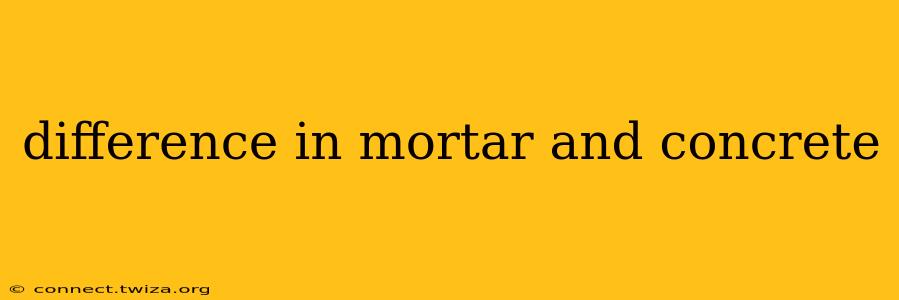Mortar and concrete are both common construction materials made from a mixture of cement, aggregates, and water. However, despite their similarities, they serve very different purposes and have distinct compositions. Understanding these differences is crucial for any construction project, whether you're a seasoned professional or a DIY enthusiast. This guide will delve into the key distinctions between mortar and concrete, answering frequently asked questions to provide a comprehensive understanding.
What is Mortar?
Mortar is a binding agent primarily used to bond bricks, blocks, and stones together. It's a paste-like mixture, typically composed of cement, sand, and water. Sometimes lime is added to enhance workability and durability. The key characteristic of mortar is its workability and its ability to adhere strongly to masonry units. It fills the gaps between these units, creating a strong and stable structure. Mortar doesn't need to bear significant compressive loads on its own; its primary function is to bind other materials together.
What is Concrete?
Concrete, on the other hand, is a structural material used to create solid elements such as slabs, foundations, walls, and pavements. It's a composite material consisting of cement, aggregates (like gravel or crushed stone), sand, and water. The larger aggregate size in concrete gives it significantly higher compressive strength compared to mortar. Concrete's primary function is to bear significant weight and resist compressive forces. It's a robust material capable of creating strong, durable structures.
What are the Key Differences Between Mortar and Concrete?
The table below summarizes the key differences between mortar and concrete:
| Feature | Mortar | Concrete |
|---|---|---|
| Primary Use | Binding masonry units | Structural element construction |
| Aggregates | Primarily fine sand | Coarse aggregates (gravel, crushed stone) and sand |
| Strength | Lower compressive strength | High compressive strength |
| Workability | More workable, easily applied | Less workable, requires specialized tools |
| Water-Cement Ratio | Generally higher than concrete | Generally lower than mortar |
| Typical Applications | Bricklaying, stonework, blocklaying | Foundations, slabs, walls, pavements |
What is the Difference in Their Uses?
This question highlights the core functional difference. Mortar's role is to bind, creating a strong bond between masonry units. It's the "glue" that holds a brick wall together. Concrete's role is to support, acting as a load-bearing structural element. It forms the foundation upon which buildings stand and creates solid, weight-bearing structures.
How Much Stronger is Concrete Than Mortar?
Concrete is significantly stronger than mortar in terms of compressive strength. This is primarily due to the inclusion of larger aggregates, which provide greater structural integrity and resistance to compressive forces. The exact strength difference can vary based on the specific mix designs, but concrete typically exhibits several times the compressive strength of mortar.
Can I Use Concrete Instead of Mortar?
No, you generally shouldn't use concrete instead of mortar. Concrete's higher strength and lower workability make it unsuitable for most masonry applications. It's too stiff to be easily worked into the joints between bricks or stones, and the excess material would be difficult to remove. Using concrete in place of mortar would likely result in a poorly constructed and structurally unsound wall.
Can I Use Mortar Instead of Concrete?
Similarly, using mortar instead of concrete for structural elements is highly discouraged. Mortar lacks the compressive strength needed to support significant loads. A structure built using mortar in place of concrete would be structurally weak and prone to failure.
Conclusion
While both mortar and concrete utilize cement, sand, and water, their distinct compositions and applications make them fundamentally different building materials. Understanding these differences is vital for successful construction projects. Choosing the correct material for the job ensures structural integrity, durability, and overall project success.
